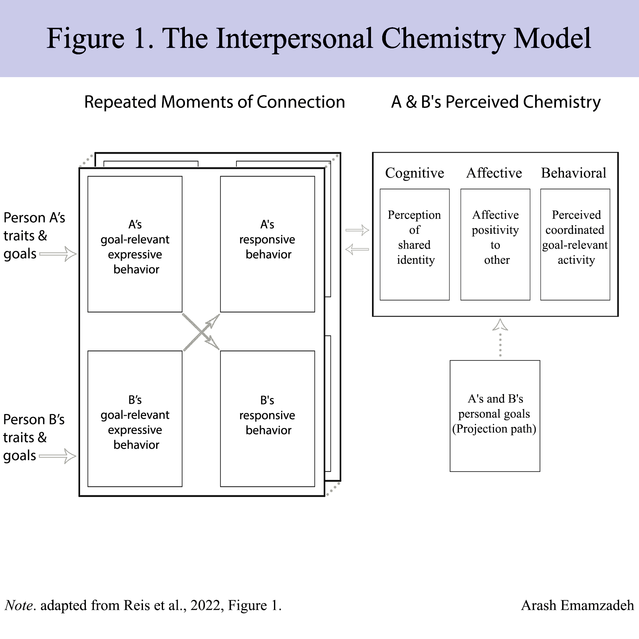Relationships
How to Improve Your Interpersonal Chemistry
Positive feelings, a shared sense of identity, and listening.
Posted April 22, 2022 Reviewed by Tyler Woods
Key points
- Interpersonal chemistry is experienced when two people perceive their interactions as more than the total of their individual contributions.
- During an interaction, chemistry is more likely if the listener supports the speaker and expresses similar or compatible feelings or goals.
- The components of chemistry include positive feelings toward the other, working together toward shared goals, and a shared sense of identity.

What does it mean to have chemistry with someone? What are the signs of chemistry? What does chemistry feel like in a romantic relationship?
For answers, we turn to a recent paper by Reis et al., published in the March issue of Perspectives on Psychological Science, which proposes a new model of interpersonal chemistry.
What is chemistry?
Partner A and Partner B are said to have chemistry if they experience something special that neither individual experiences alone or in relationships with others.
Chemistry applies not only to romantic relationships but also to non-romantic relationships—those between friends, players in a team, collaborating artists, and others. Chemistry does not refer to instant attraction or magnetism. Chemistry, or the feeling of clicking or “meshing well together,” emerges only after repeated communication and responsiveness between two people. Some aspects of chemistry are nonverbal and even unconscious (e.g., the natural mirroring of facial expressions or body language).
A model of interpersonal chemistry
The new model of interpersonal chemistry advanced by Reis et al. discusses the concept of moments of connection—i.e., interactions between two people in which their “goals, feelings, needs, or wishes...are expressed and responded to in a supportive and encouraging way.”
These interactions can be behavioral (e.g., playing the other person’s favorite music), verbal (e.g., talking about what one values), or nonverbal (e.g., nodding, smiling).
Chemistry is more likely to be experienced if:
- The listener’s responses help the speaker feel a sense of safety and trust, and that responses convey appreciation, understanding, and care.
- There is mutuality, so the person who was initially listening is later given the chance to voice their own feelings and goals—particularly feelings and goals similar to or compatible with their partner’s.
It is only when this cycle of back-and-forth occurs repeatedly and “moments of connection” accumulate that a sense of chemistry can be felt.
Other factors that may increase chemistry include the characteristics of an individual that make him or her appear more likable and responsive.
For example, more likable individuals tend to be expressive, agreeable, friendly, self-confident, optimistic, charismatic, and attractive. And those considered responsive tend to be good listeners, warm, and effective at perspective-taking.
For an overview of the model, see Figure 1. On the left side are behaviors, or what chemistry “looks like,” which is what we have been talking about so far. Specifically, A’s expressive behavior (influenced by personality traits and goals) interacts with B’s responsiveness, creating moments of connection. The same is true of B’s expressive behavior and A’s responsiveness.

The three components of chemistry
On the right side of Figure 1 is the perception of chemistry, or what chemistry “feels like.” Here you find three components of perceived chemistry: affective (i.e., emotional), behavioral, and cognitive. These are described below.
- Affective: Refers to positive feelings, such as liking, attraction, warmth, caring, admiration, and being happy for, say, a romantic partner’s success. Even more important are positive feelings that are shared (e.g., shared laughter).
- Behavioral: When there is chemistry, both parties believe that if they work together (rather than work alone), they will have more success in achieving their goals. These goals may be social (in friendships), related to lifestyle and sex (in romantic relationships), or related to efficiency (in work relationships).
- Cognitive: Chemistry is associated with the perception of being similar or complementary in terms of goals, beliefs, values, personality, preferences… This perception may influence the development of a shared identity (e.g., “couple identity,” in romantic relationships).
The only part of the model we have yet to discuss is the projection path—people projecting their thoughts and feelings onto their romantic partner (bottom right of Figure 1).
Here is an example. Suppose Person A has a sexual encounter with a new partner, B. Person A may assume B found the experience just as gratifying as A did. In other words, A is projecting his/her own thoughts and feelings onto B.
Projection is more likely to play a role in cases where one person feels a spark but the other doesn’t.
Note, projection is not a necessary component of chemistry (hence the dotted line in Figure 1).
Takeaway
Interpersonal chemistry involves two individuals experiencing their interaction as adding up to more than the sum of their individual contributions to it. Chemistry plays a role in romantic attraction, sexual attraction, and the feeling that you “click” with your date or spouse—or a new friend, coworker, and others.
The development of chemistry is promoted by repeated moments of connection—interactions where partners take turns sharing openly (whether their feelings, needs, or goals) and listening responsively.
Chemistry is particularly important in romantic relationships, so here are some potential ways you and your romantic partner can build chemistry (or improve the chemistry) in your relationship:
- When listening, be responsive. Aim to create a sense of safety and trust that makes intimacy possible. Depending on the situation, this may include listening intently to fully understand your partner’s perspective, expressing emotional validation and affection, providing encouragement, etc.
- When speaking, share your feelings, thoughts, needs, desires, and dreams—in particular, things that you have in common (e.g., similar interests, attitudes, ambitions).
- Make sure there is a sense of mutuality, not just one person always speaking and the other always listening. Even if you are a great listener, for instance, there can be no chemistry if you do not feel heard and supported when you are the one speaking.
Facebook image: Nebojsa Tatomirov/Shutterstock




